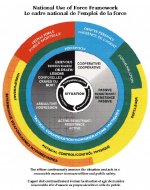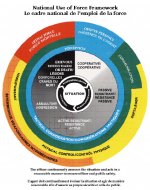- Reaction score
- 2,090
- Points
- 1,160
Section 27 also goes directly towards the use of force to prevent (immediate future tense)the commission of an offence and in R v Hebert the Supreme Court confirmed that Section 27 includes an offence that also is being committed (present tense) in the moment:FJAG said:In respect to an arrest under s 494(2), s 25 of the CCC provides that anyone who is authorized or required by law to do anything in the administration or enforcement of the law (specifically here, making an arrest) is justified in using such force which is reasonably necessary if acting on reasonable grounds.
The problem, as with much of the law, is determining what the facts are at any given time and if the response or acts of the "innocent" person are in fact reasonable in the circumstances. That generally runs on a continuum. At one end using deadly force to protect yourself from imminent deadly force is fairly clear and obvious. At the other is the question of how much force is reasonable to apprehend a criminal who is trying to escape or evade capture and no longer a risk to the property.
The police and the crown should analyze those situations in order to determine if charges should be laid against the "innocent" party. Regrettably, in many cases they tend to charge and let the trial sort it out. I don't think that this is necessarily out of an overabundance of caution but because, more often than not, there are conflicting stories muddy the waters.
At the end of the day, the questions may need to be answered by either a judge or jury who, of course, will be analysing the situation with typical twenty/twenty hindsight in a quiet courtroom rather than the chaos of a farmyard.
:cheers:
"Similarly, s. 27 justifies the use of force which is reasonably necessary to prevent the commission of an offence. This section is of general application and the person asserting the justification need not be a peace or public officer or a member of a restricted class of persons. However, the section is clearly designed to permit an innocent bystander, who witnesses an offence being or about to be committed, to use force to prevent the offence from occurring.”
This does allow a person to step in and use force for example, to break up a bar fight, prevent or stop any type of assault, theft, etc. as long as the force applied is not excessive (ie reasonable and proportionate) in the circumstances. Curiously, the section says nothing about arresting and then delivering the offender to the police.
- " ...Section 27 (1) ... requires that the trier of fact apply the accused’s perception of the situation and his or her belief as to the reaction necessary to the situation as long as there is a reasonably verifiable basis for that perception...... I will repeat yet again that an accused does not have an onus of demonstrating that he or she was acting in defence of another; rather, the Crown has the onus of demonstrating the contrary beyond a reasonable doubt."
"The sections of the Code authorizing the use of force in defence of a person or property, to prevent crime, and to apprehend offenders, in general, express in greater detail the great principle of the common law that the use of force in such circumstances is subject to the restriction that the force used is necessary; that is, that the harm sought to be prevented could not be prevented by less violent means and that the injury or harm done by, or which might reasonably be anticipated from the force used, is not disproportionate to the injury or harm it is intended to prevent."




